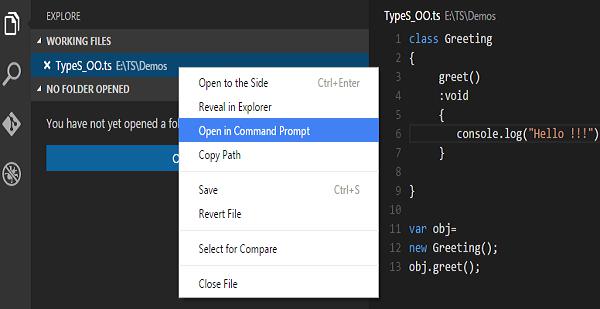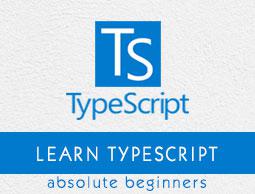TypeScript - Basic Syntax
Syntax defines a set of rules for writing programs. Every language specification defines its own syntax. A TypeScript program is composed of −
- Modules
- Functions
- Variables
- Statements and Expressions
- Comments
Your First TypeScript Code
Let us start with the traditional “Hello World” example −
var message:string = "Hello World"
console.log(message)
On compiling, it will generate following JavaScript code.
//Generated by typescript 1.8.10
var message = "Hello World";
console.log(message);
Line 1 declares a variable by the name message. Variables are a mechanism to store values in a program.
Line 2 prints the variable’s value to the prompt. Here, console refers to the terminal window. The function log () is used to display text on the screen.
Compile and Execute a TypeScript Program
Let us see how to compile and execute a TypeScript program using Visual Studio Code. Follow the steps given below −
Step 1 − Save the file with .ts extension. We shall save the file as Test.ts. The code editor marks errors in the code, if any, while you save it.
Step 2 − Right-click the TypeScript file under the Working Files option in VS Code’s Explore Pane. Select Open in Command Prompt option.

Step 3 − To compile the file use the following command on the terminal window.
tsc Test.ts
Step 4 − The file is compiled to Test.js. To run the program written, type the following in the terminal.
node Test.js
Compiler Flags
Compiler flags enable you to change the behavior of the compiler during compilation. Each compiler flag exposes a setting that allows you to change how the compiler behaves.
The following table lists some common flags associated with the TSC compiler. A typical command-line usage uses some or all switches.
| S.No. |
Compiler flag & Description |
| 1. |
--help
Displays the help manual
|
| 2. |
--module
Load external modules
|
| 3. |
--target
Set the target ECMA version
|
| 4. |
--declaration
Generates an additional .d.ts file
|
| 5. |
--removeComments
Removes all comments from the output file
|
| 6. |
--out
Compile multiple files into a single output file
|
| 7. |
--sourcemap
Generate a sourcemap (.map) files
|
| 8. |
--module noImplicitAny
Disallows the compiler from inferring the any type
|
| 9. |
--watch
Watch for file changes and recompile them on the fly
|
Note − Multiple files can be compiled at once.
tsc file1.ts, file2.ts, file3.ts
Identifiers in TypeScript
Identifiers are names given to elements in a program like variables, functions etc. The rules for identifiers are −
Identifiers can include both, characters and digits. However, the identifier cannot begin with a digit.
Identifiers cannot include special symbols except for underscore (_) or a dollar sign ($).
Identifiers cannot be keywords.
They must be unique.
Identifiers are case-sensitive.
Identifiers cannot contain spaces.
The following tables lists a few examples of valid and invalid identifiers −
| Valid identifiers |
Invalid identifiers |
| firstName |
Var |
| first_name |
first name |
| num1 |
first-name |
| $result |
1number |
TypeScript ─ Keywords
Keywords have a special meaning in the context of a language. The following table lists some keywords in TypeScript.
| break |
as |
any |
switch |
| case |
if |
throw |
else |
| var |
number |
string |
get |
| module |
type |
instanceof |
typeof |
| public |
private |
enum |
export |
| finally |
for |
while |
void |
| null |
super |
this |
new |
| in |
return |
true |
false |
| any |
extends |
static |
let |
| package |
implements |
interface |
function |
| new |
try |
yield |
const |
| continue |
do |
catch |
Whitespace and Line Breaks
TypeScript ignores spaces, tabs, and newlines that appear in programs. You can use spaces, tabs, and newlines freely in your program and you are free to format and indent your programs in a neat and consistent way that makes the code easy to read and understand.
TypeScript is Case-sensitive
TypeScript is case-sensitive. This means that TypeScript differentiates between uppercase and lowercase characters.
Semicolons are optional
Each line of instruction is called a statement. Semicolons are optional in TypeScript.
Example
console.log("hello world")
console.log("We are learning TypeScript")
A single line can contain multiple statements. However, these statements must be separated by a semicolon.
Comments in TypeScript
Comments are a way to improve the readability of a program. Comments can be used to include additional information about a program like author of the code, hints about a function/ construct etc. Comments are ignored by the compiler.
TypeScript supports the following types of comments −
Example
//this is single line comment
/* This is a
Multi-line comment
*/
TypeScript and Object Orientation
TypeScript is Object-Oriented JavaScript. Object Orientation is a software development paradigm that follows real-world modelling. Object Orientation considers a program as a collection of objects that communicate with each other via mechanism called methods. TypeScript supports these object oriented components too.
Object − An object is a real time representation of any entity. According to Grady Brooch, every object must have three features −
State − described by the attributes of an object
Behavior − describes how the object will act
Identity − a unique value that distinguishes an object from a set of similar such objects.
Class − A class in terms of OOP is a blueprint for creating objects. A class encapsulates data for the object.
Method − Methods facilitate communication between objects.
Example: TypeScript and Object Orientation
class Greeting {
greet():void {
console.log("Hello World!!!")
}
}
var obj = new Greeting();
obj.greet();
The above example defines a class Greeting. The class has a method greet (). The method prints the string “Hello World” on the terminal. The new keyword creates an object of the class (obj). The object invokes the method greet ().
On compiling, it will generate following JavaScript code.
//Generated by typescript 1.8.10
var Greeting = (function () {
function Greeting() {
}
Greeting.prototype.greet = function () {
console.log("Hello World!!!");
};
return Greeting;
}());
var obj = new Greeting();
obj.greet()
The output of the above program is given below −
Hello World!!!



